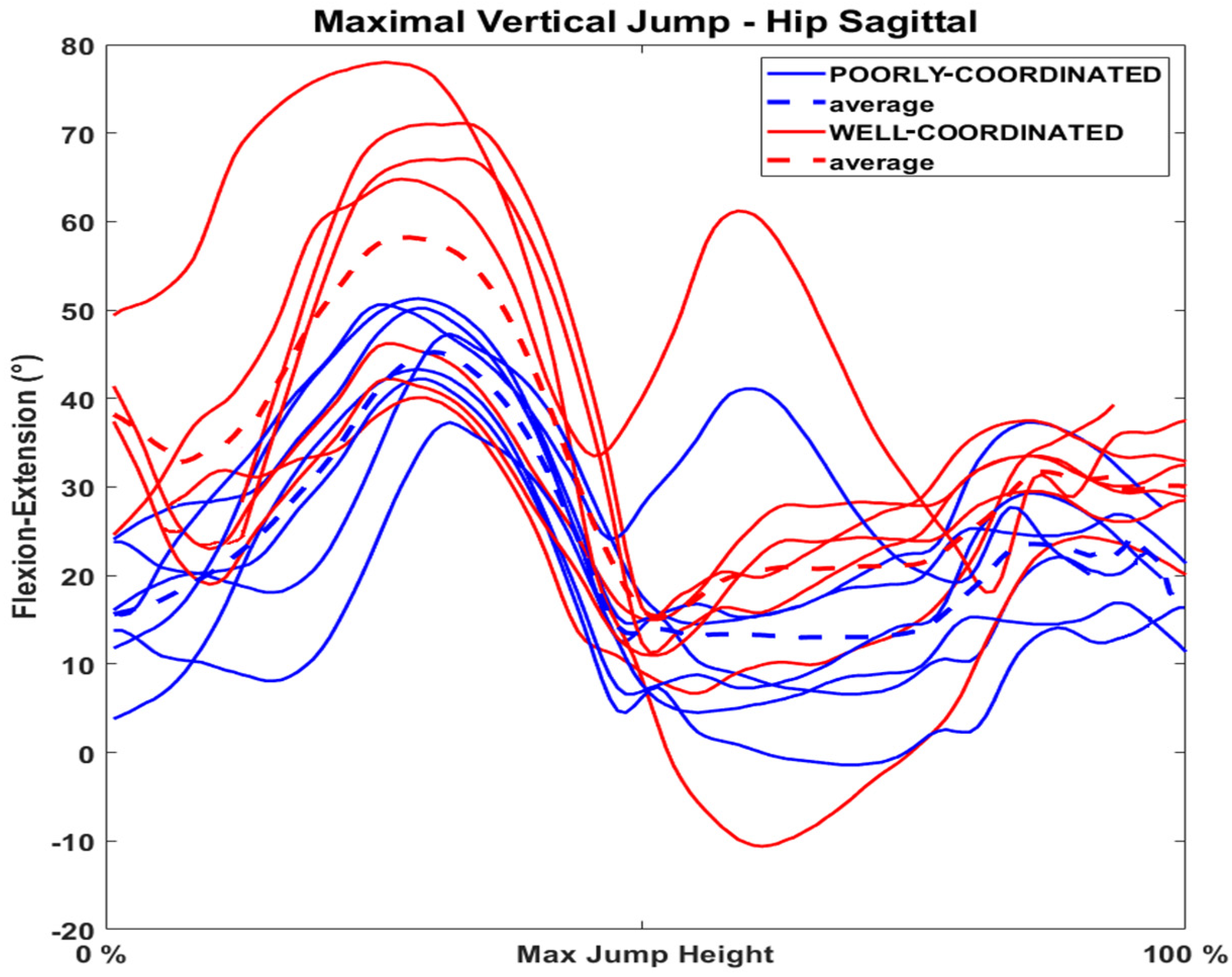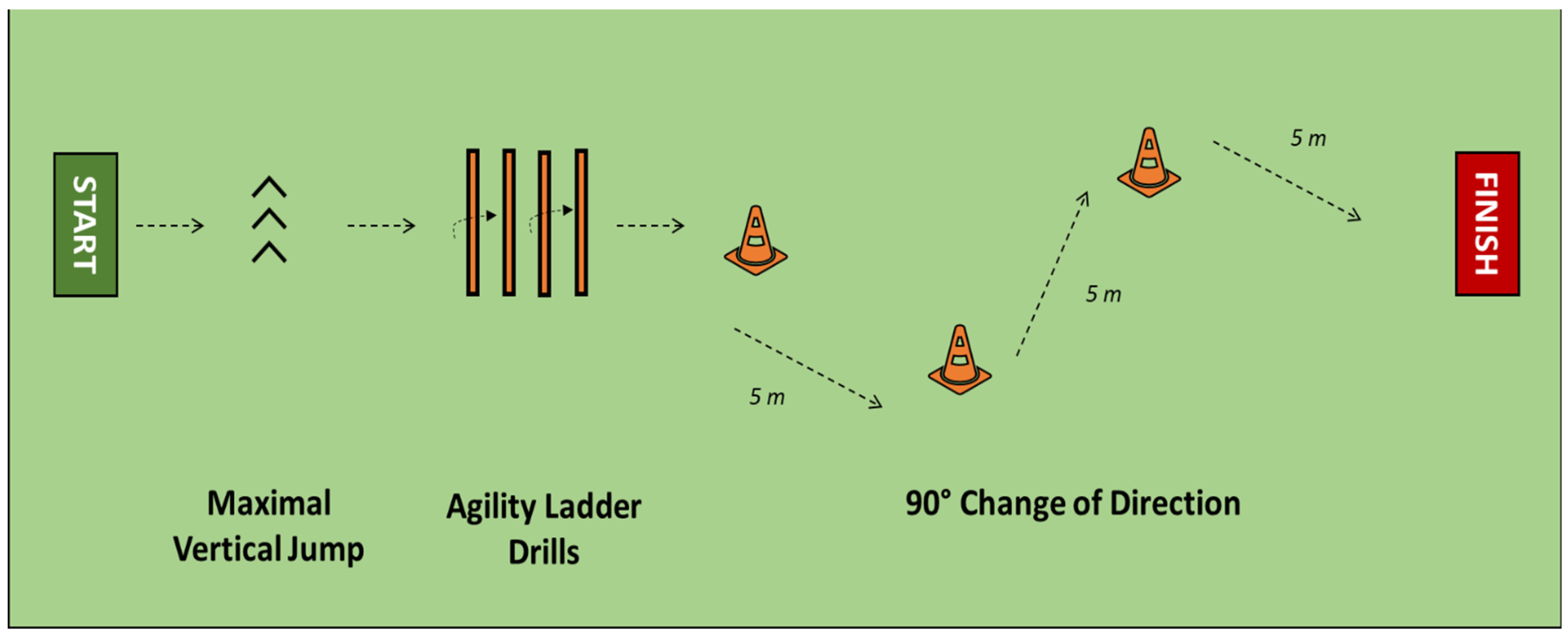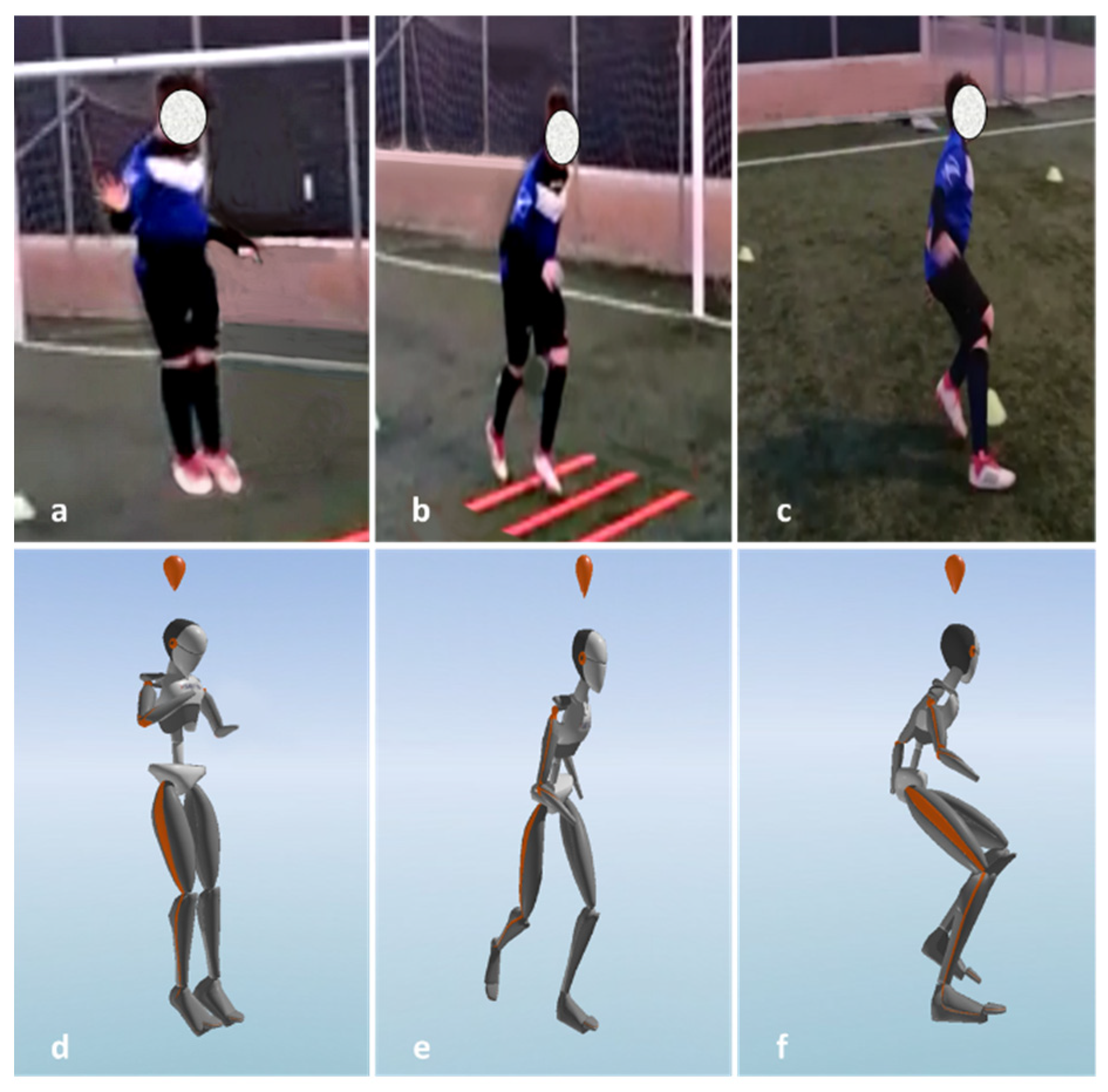Poor Motor Coordination Elicits Altered Lower Limb Biomechanics in Young Football (Soccer) Players: Implications for Injury Prevention through Wearable Sensors
Abstract
:1. Introduction
2. Materials and Methods
2.1. Participants
2.2. Data Collection
2.3. Data Analysis
2.4. Statistical Analysis
3. Results
3.1. Harre Circuit Test (Coordination)
3.2. Training Drill (Biomechanics)
4. Discussion
5. Conclusions
Author Contributions
Funding
Institutional Review Board Statement
Informed Consent Statement
Data Availability Statement
Acknowledgments
Conflicts of Interest
Appendix A

Appendix B

References
- Watson, A.; Mjaanes, J.M.; Council on Sports Medicine and Fitness. Soccer Injuries in Children and Adolescents. Pediatrics 2019, 144. [Google Scholar] [CrossRef] [Green Version]
- Dietvorst, M.; Brzoskowski, M.H.; van der Steen, M.; Delvaux, E.; Janssen, R.P.A.; Van Melick, N. Limited Evidence for Return to Sport Testing after ACL Reconstruction in Children and Adolescents under 16 Years: A Scoping Review. J. Exp. Orthop. 2020, 7, 83. [Google Scholar] [CrossRef] [PubMed]
- Moksnes, H.; Engebretsen, L.; Seil, R. The ESSKA Paediatric Anterior Cruciate Ligament Monitoring Initiative. Knee Surg. Sports Traumatol. Arthrosc. 2016, 24, 680–687. [Google Scholar] [CrossRef] [Green Version]
- Zebis, M.K.; Bencke, J.; Andersen, L.L.; Døssing, S.; Alkjaer, T.; Magnusson, S.P.; Kjaer, M.; Aagaard, P. The Effects of Neuromuscular Training on Knee Joint Motor Control during Sidecutting in Female Elite Soccer and Handball Players. Clin. J. Sport Med. Off. J. Can. Acad. Sport Med. 2008, 18, 329–337. [Google Scholar] [CrossRef] [Green Version]
- Zebis, M.K.; Aagaard, P.; Andersen, L.L.; Hölmich, P.; Clausen, M.B.; Brandt, M.; Husted, R.S.; Lauridsen, H.B.; Curtis, D.J.; Bencke, J. First-Time Anterior Cruciate Ligament Injury in Adolescent Female Elite Athletes: A Prospective Cohort Study to Identify Modifiable Risk Factors. Knee Surg. Sports Traumatol. Arthrosc. 2021. [Google Scholar] [CrossRef] [PubMed]
- Grooms, D.R.; Palmer, T.; Onate, J.A.; Myer, G.D.; Grindstaff, T. Soccer-Specific Warm-Up and Lower Extremity Injury Rates in Collegiate Male Soccer Players. J. Athl. Train. 2013, 48, 782–789. [Google Scholar] [CrossRef] [PubMed] [Green Version]
- Slauterbeck, J.R.; Choquette, R.; Tourville, T.W.; Krug, M.; Mandelbaum, B.R.; Vacek, P.; Beynnon, B.D. Implementation of the FIFA 11+ Injury Prevention Program by High School Athletic Teams Did Not Reduce Lower Extremity Injuries: A Cluster Randomized Controlled Trial. Am. J. Sports Med. 2019, 47, 2844–2852. [Google Scholar] [CrossRef] [PubMed]
- Soligard, T.; Nilstad, A.; Steffen, K.; Myklebust, G.; Holme, I.; Dvorak, J.; Bahr, R.; Andersen, T.E. Compliance with a Comprehensive Warm-up Programme to Prevent Injuries in Youth Football. Br. J. Sports Med. 2010, 44, 787–793. [Google Scholar] [CrossRef]
- Steffen, K.; Emery, C.A.; Romiti, M.; Kang, J.; Bizzini, M.; Dvorak, J.; Finch, C.F.; Meeuwisse, W.H. High Adherence to a Neuromuscular Injury Prevention Programme (FIFA 11+) Improves Functional Balance and Reduces Injury Risk in Canadian Youth Female Football Players: A Cluster Randomised Trial. Br. J. Sports Med. 2013, 47, 794–802. [Google Scholar] [CrossRef] [Green Version]
- Weitz, F.K.; Sillanpää, P.J.; Mattila, V.M. The Incidence of Paediatric ACL Injury Is Increasing in Finland. Knee Surg. Sports Traumatol. Arthrosc. 2020, 28, 363–368. [Google Scholar] [CrossRef] [Green Version]
- van der Kruk, E.; Reijne, M.M. Accuracy of Human Motion Capture Systems for Sport Applications; State-of-the-Art Review. Eur. J. Sport Sci. 2018, 18, 806–819. [Google Scholar] [CrossRef] [PubMed]
- Verheul, J.; Nedergaard, N.J.; Vanrenterghem, J.; Robinson, M.A. Measuring Biomechanical Loads in Team Sports—From Lab to Field. Sci. Med. Footb. 2020, 4, 246–252. [Google Scholar] [CrossRef] [Green Version]
- Di Paolo, S.; Lopomo, N.F.; Della Villa, F.; Paolini, G.; Figari, G.; Bragonzoni, L.; Grassi, A.; Zaffagnini, S. Rehabilitation and Return to Sport Assessment after Anterior Cruciate Ligament Injury: Quantifying Joint Kinematics during Complex High-Speed Tasks through Wearable Sensors. Sensors 2021, 21, 2331. [Google Scholar] [CrossRef]
- Harre, D.; Barsch, J. Principles of Sports Training: Introduction to the Theory and Methods of Training; Sportverlag: Berlin, Gremany, 1982. [Google Scholar]
- Chiodera, P.; Volta, E.; Gobbi, G.; Milioli, M.A.; Mirandola, P.; Bonetti, A.; Delsignore, R.; Bernasconi, S.; Anedda, A.; Vitale, M. Specifically Designed Physical Exercise Programs Improve Children’s Motor Abilities. Scand. J. Med. Sci. Sports 2008, 18, 179–187. [Google Scholar] [CrossRef]
- Trecroci, A.; Cavaggioni, L.; Caccia, R.; Alberti, G. Jump Rope Training: Balance and Motor Coordination in Preadolescent Soccer Players. J. Sports Sci. Med. 2015, 14, 792–798. [Google Scholar]
- Dallolio, L.; Ceciliani, A.; Sanna, T.; Garulli, A.; Leoni, E. Proposal for an Enhanced Physical Education Program in the Primary School: Evaluation of Feasibility and Effectiveness in Improving Physical Skills and Fitness. J. Phys. Act. Health 2016, 13, 1025–1034. [Google Scholar] [CrossRef]
- Wilczyński, B.; Hinca, J.; Ślęzak, D.; Zorena, K. The Relationship between Dynamic Balance and Jumping Tests among Adolescent Amateur Rugby Players. A Preliminary Study. Int. J. Environ. Res. Public Health 2021, 18, 312. [Google Scholar] [CrossRef] [PubMed]
- Earp, J.E.; Joseph, M.; Kraemer, W.J.; Newton, R.U.; Comstock, B.A.; Fragala, M.S.; Dunn-Lewis, C.; Solomon-Hill, G.; Penwell, Z.R.; Powell, M.D.; et al. Lower-Body Muscle Structure and Its Role in Jump Performance during Squat, Countermovement, and Depth Drop Jumps. J. Strength Cond. Res. 2010, 24, 722–729. [Google Scholar] [CrossRef] [PubMed]
- Dicesare, C.A.; Minai, A.A.; Riley, M.A.; Ford, K.R.; Hewett, T.E.; Myer, G.D. Distinct Coordination Strategies Associated with the Drop Vertical Jump Task. Med. Sci. Sports Exerc. 2020, 52, 1088–1098. [Google Scholar] [CrossRef] [PubMed]
- Michailidis, Y.; Fatouros, I.G.; Primpa, E.; Michailidis, C.; Avloniti, A.; Chatzinikolaou, A.; Barbero-Álvarez, J.C.; Tsoukas, D.; Douroudos, I.I.; Draganidis, D.; et al. Plyometrics’ Trainability in Preadolescent Soccer Athletes. J. Strength Cond. Res. 2013, 27, 38–49. [Google Scholar] [CrossRef]
- Afonso, J.; da Costa, I.T.; Camões, M.; Silva, A.; Lima, R.F.; Milheiro, A.; Martins, A.; Laporta, L.; Nakamura, F.Y.; Clemente, F.M. The Effects of Agility Ladders on Performance: A Systematic Review. Int. J. Sports Med. 2020, 41, 720–728, Correction in 2020. [Google Scholar] [PubMed]
- Altmann, S.; Ringhof, S.; Neumann, R.; Woll, A.; Rumpf, M.C. Validity and Reliability of Speed Tests Used in Soccer: A Systematic Review. PLoS ONE 2019, 14, e0220982. [Google Scholar] [CrossRef] [Green Version]
- Chiwaridzo, M.; Oorschot, S.; Dambi, J.M.; Ferguson, G.D.; Bonney, E.; Mudawarima, T.; Tadyanemhandu, C.; Smits-Engelsman, B.C.M. A Systematic Review Investigating Measurement Properties of Physiological Tests in Rugby. BMC Sports Sci. Med. Rehabil. 2017, 9, 24. [Google Scholar] [CrossRef] [PubMed] [Green Version]
- Beekhuizen, K.S.; Davis, M.D.; Kolber, M.J.; Cheng, M.-S.S. Test-Retest Reliability and Minimal Detectable Change of the Hexagon Agility Test. J. Strength Cond. Res. 2009, 23, 2167–2171. [Google Scholar] [CrossRef]
- Cohen, J. Statistical Power Analysis for the Behavioral Sciences, 2nd ed.; Lawrence Erlbaum Associates: Hillsdale, NJ, USA, 1988; ISBN 978-0-8058-0283-2. [Google Scholar]
- Sawilowsky, S.S. New Effect Size Rules of Thumb. J. Mod. App. Stat. Meth. 2009, 8, 597–599. [Google Scholar] [CrossRef]
- Della Villa, F.; Buckthorpe, M.; Grassi, A.; Nabiuzzi, A.; Tosarelli, F.; Zaffagnini, S.; Della Villa, S. Systematic Video Analysis of ACL Injuries in Professional Male Football (Soccer): Injury Mechanisms, Situational Patterns and Biomechanics Study on 134 Consecutive Cases. Br. J. Sports Med. 2020. [Google Scholar] [CrossRef]
- Ardern, C.L.; Ekås, G.R.; Grindem, H.; Moksnes, H.; Anderson, A.; Chotel, F.; Cohen, M.; Forssblad, M.; Ganley, T.J.; Feller, J.A.; et al. Prevention, Diagnosis and Management of Paediatric ACL Injuries. Br. J. Sports Med. 2018, 52, 1297–1298. [Google Scholar] [CrossRef]
- Silvers-Granelli, H.J.; Bizzini, M.; Arundale, A.; Mandelbaum, B.R.; Snyder-Mackler, L. Does the FIFA 11+ Injury Prevention Program Reduce the Incidence of ACL Injury in Male Soccer Players? Clin. Orthop. Relat. Res. 2017, 475, 2447–2455. [Google Scholar] [CrossRef]
- Burboa, G.J.; Inostroza, M.M.; Bahamondes, F.M.; Lillo, U.P.; Hinzpeter, C.J. Comparison of the Angular Compartment of Hip Flexion Before and After Training in 11 to 12-Year-Old Soccer Players. JSEM 2019, 1, 4–10. [Google Scholar] [CrossRef]
- Leppänen, M.; Pasanen, K.; Kujala, U.M.; Vasankari, T.; Kannus, P.; Äyrämö, S.; Krosshaug, T.; Bahr, R.; Avela, J.; Perttunen, J.; et al. Stiff Landings Are Associated With Increased ACL Injury Risk in Young Female Basketball and Floorball Players. Am. J. Sports Med. 2017, 45, 386–393. [Google Scholar] [CrossRef]
- Kotsifaki, A.; Korakakis, V.; Whiteley, R.; Van Rossom, S.; Jonkers, I. Measuring Only Hop Distance during Single Leg Hop Testing Is Insufficient to Detect Deficits in Knee Function after ACL Reconstruction: A Systematic Review and Meta-Analysis. Br. J. Sports Med. 2020, 54, 139–153. [Google Scholar] [CrossRef]
- Nguyen, A.-D.; Taylor, J.B.; Wimbish, T.G.; Keith, J.L.; Ford, K.R. Preferred Hip Strategy During Landing Reduces Knee Abduction Moment in Collegiate Female Soccer Players. J. Sport Rehabil. 2018, 27, 213–217. [Google Scholar] [CrossRef] [PubMed]
- Pollard, C.D.; Sigward, S.M.; Powers, C.M. Limited Hip and Knee Flexion during Landing Is Associated with Increased Frontal Plane Knee Motion and Moments. Clin. Biomech. 2010, 25, 142–146. [Google Scholar] [CrossRef] [Green Version]
- Ward, S.H.; Blackburn, J.T.; Padua, D.A.; Stanley, L.E.; Harkey, M.S.; Luc-Harkey, B.A.; Pietrosimone, B. Quadriceps Neuromuscular Function and Jump-Landing Sagittal-Plane Knee Biomechanics After Anterior Cruciate Ligament Reconstruction. J. Athl. Train. 2018, 53, 135–143. [Google Scholar] [CrossRef] [Green Version]
- King, E.; Richter, C.; Daniels, K.A.J.; Franklyn-Miller, A.; Falvey, E.; Myer, G.D.; Jackson, M.; Moran, R.; Strike, S. Biomechanical but Not Strength or Performance Measures Differentiate Male Athletes Who Experience ACL Reinjury on Return to Level 1 Sports. Am. J. Sports Med. 2021, 49, 918–927. [Google Scholar] [CrossRef]
- Dempsey, A.R.; Lloyd, D.G.; Elliott, B.C.; Steele, J.R.; Munro, B.J. Changing Sidestep Cutting Technique Reduces Knee Valgus Loading. Am. J. Sports Med. 2009, 37, 2194–2200. [Google Scholar] [CrossRef] [PubMed] [Green Version]
- Hewett, T.E.; Myer, G.D.; Ford, K.R.; Heidt, R.S.; Colosimo, A.J.; McLean, S.G.; van den Bogert, A.J.; Paterno, M.V.; Succop, P. Biomechanical Measures of Neuromuscular Control and Valgus Loading of the Knee Predict Anterior Cruciate Ligament Injury Risk in Female Athletes: A Prospective Study. Am. J. Sports Med. 2005, 33, 492–501. [Google Scholar] [CrossRef] [Green Version]
- Buckthorpe, M.; Della Villa, F.; Della Villa, S.; Roi, G.S. On-Field Rehabilitation Part 1: 4 Pillars of High-Quality On-Field Rehabilitation Are Restoring Movement Quality, Physical Conditioning, Restoring Sport-Specific Skills, and Progressively Developing Chronic Training Load. J. Orthop. Sports Phys. Ther. 2019, 49, 565–569. [Google Scholar] [CrossRef]
- Sigward, S.M.; Powers, C.M. Loading Characteristics of Females Exhibiting Excessive Valgus Moments during Cutting. Clin. Biomech. 2007, 22, 827–833. [Google Scholar] [CrossRef]
- Della Villa, F.; Di Paolo, S.; Santagati, D.; Della Croce, E.; Lopomo, N.F.; Grassi, A.; Zaffagnini, S. A 2D Video-Analysis Scoring System of 90° Change of Direction Technique Identifies Football Players with High Knee Abduction Moment. Knee Surg. Sports Traumatol. Arthrosc. 2021. [Google Scholar] [CrossRef]
- Dix, C.; Arundale, A.; Silvers-Granelli, H.; Marmon, A.; Zarzycki, R.; Snyder-Mackler, L. Biomechanical Measures during Two Sport-Specific Tasks Differentiate between Soccer Players Who go on to Anterior Cruciate Ligament Injury and Those who do Not: A Prospective Cohort Analysis. Int. J. Sports Phys. Ther. 2020, 15, 928–935. [Google Scholar] [CrossRef] [PubMed]
- Hewett, T.E.; Bates, N.A. Preventive Biomechanics: A Paradigm Shift With a Translational Approach to Injury Prevention. Am. J. Sports Med. 2017, 45, 2654–2664. [Google Scholar] [CrossRef]
- Hewett, T.E.; Ford, K.R.; Xu, Y.Y.; Khoury, J.; Myer, G.D. Effectiveness of Neuromuscular Training Based on the Neuromuscular Risk Profile. Am. J. Sports Med. 2017, 45, 2142–2147. [Google Scholar] [CrossRef]
- Räisänen, A.M.; Pasanen, K.; Krosshaug, T.; Vasankari, T.; Kannus, P.; Heinonen, A.; Kujala, U.M.; Avela, J.; Perttunen, J.; Parkkari, J. Association between Frontal Plane Knee Control and Lower Extremity Injuries: A Prospective Study on Young Team Sport Athletes. BMJ Open Sport Exerc. Med. 2018, 4, e000311. [Google Scholar] [CrossRef] [PubMed]
- Waldén, M.; Krosshaug, T.; Bjørneboe, J.; Andersen, T.E.; Faul, O.; Hägglund, M. Three Distinct Mechanisms Predominate in Non-Contact Anterior Cruciate Ligament Injuries in Male Professional Football Players: A Systematic Video Analysis of 39 Cases. Br. J. Sports Med. 2015, 49, 1452–1460. [Google Scholar] [CrossRef] [Green Version]
- Dos’Santos, T.; Bishop, C.; Thomas, C.; Comfort, P.; Jones, P.A. The Effect of Limb Dominance on Change of Direction Biomechanics: A Systematic Review of Its Importance for Injury Risk. Phys. Ther. Sport 2019, 37, 179–189. [Google Scholar] [CrossRef] [PubMed]
- Pollard, C.D.; Norcross, M.F.; Johnson, S.T.; Stone, A.E.; Chang, E.; Hoffman, M.A. A Biomechanical Comparison of Dominant and Non-Dominant Limbs during a Side-Step Cutting Task. Sports Biomech. 2020, 19, 271–279. [Google Scholar] [CrossRef]
- Mokhtarzadeh, H.; Ewing, K.; Janssen, I.; Yeow, C.-H.; Brown, N.; Lee, P.V.S. The Effect of Leg Dominance and Landing Height on ACL Loading among Female Athletes. J. Biomech. 2017, 60, 181–187. [Google Scholar] [CrossRef] [PubMed]
- Romanchuk, N.J.; Del Bel, M.J.; Benoit, D.L. Sex-Specific Landing Biomechanics and Energy Absorption during Unanticipated Single-Leg Drop-Jumps in Adolescents: Implications for Knee Injury Mechanics. J. Biomech. 2020, 113, 110064. [Google Scholar] [CrossRef]
- Petrucci, M.; Petrigna, L.; Pomara, F.; Piccione, M.C.; Alesi, M.; Bianco, A. Validation in Young Soccer Players of the Modified Version of the Harre Circuit Test: The Petrucci Ability Test. Montenegrin J. Sports Sci. Med. 2021, 10, 67–71. [Google Scholar] [CrossRef]
- Weir, G.; van Emmerik, R.; Jewell, C.; Hamill, J. Coordination and Variability during Anticipated and Unanticipated Sidestepping. Gait Posture 2019, 67, 1–8. [Google Scholar] [CrossRef] [PubMed]


| PC Group | WC Group | Diff % | Effect Size | p-Value | |
|---|---|---|---|---|---|
| Joint angles (°) | |||||
| Maximal Vertical Jump | |||||
| Hip flexion peak, dominant | 44.1 ± 7.7 | 59.8 ± 12.8 | −36% | 1.5 | 0.019 |
| Hip flexion peak, non-dominant | 42.8 ± 7.9 | 61.2 ± 10.6 | −43% | 2.0 | 0.004 |
| Knee varus peak, non-dominant | −4.8 ± 2.4 | −10.3 ± 2.8 | −116% | 2.1 | 0.008 |
| Agility Ladder Drills | |||||
| Hip flexion peak, dominant | 50.4 ± 7.3 | 64.0 ± 7.8 | −27% | 1.8 | 0.006 |
| Hip flexion peak, non-dominant | 48.8 ± 8.3 | 60.2 ± 6.9 | −23% | 1.5 | 0.017 |
| Change of direction | |||||
| Hip IE range, dominant | 28.0 ± 4.6 | 21.5 ± 4.3 | +23% | 1.5 | 0.019 |
| Joint accelerations (m/s2) | |||||
| Maximal Vertical Jump | |||||
| Ankle V range, non-dominant | 163.6 ± 31.8 | 232.3 ± 51.9 | −42% | 1.6 | 0.014 |
| Dominant | Non-Dominant | Diff % | Effect Size | p-Value | |
|---|---|---|---|---|---|
| Joint angles (°) | |||||
| Change of direction | |||||
| Knee VV range, PC Group | 23.2 ± 6.7 | 14.5 ± 3.5 | +38% | 1.6 | 0.013 |
| Joint accelerations (m/s2) | |||||
| Change of direction | |||||
| Knee V peak (+), PC Group | 119.9 ± 19.8 | 72.7 ± 20.5 | +39% | 2.3 | 0.001 |
| Knee V range, PC Group | 183.9 ± 36 | 126.6 ± 37.4 | +31% | 1.6 | 0.013 |
Publisher’s Note: MDPI stays neutral with regard to jurisdictional claims in published maps and institutional affiliations. |
© 2021 by the authors. Licensee MDPI, Basel, Switzerland. This article is an open access article distributed under the terms and conditions of the Creative Commons Attribution (CC BY) license (https://creativecommons.org/licenses/by/4.0/).
Share and Cite
Di Paolo, S.; Zaffagnini, S.; Pizza, N.; Grassi, A.; Bragonzoni, L. Poor Motor Coordination Elicits Altered Lower Limb Biomechanics in Young Football (Soccer) Players: Implications for Injury Prevention through Wearable Sensors. Sensors 2021, 21, 4371. https://doi.org/10.3390/s21134371
Di Paolo S, Zaffagnini S, Pizza N, Grassi A, Bragonzoni L. Poor Motor Coordination Elicits Altered Lower Limb Biomechanics in Young Football (Soccer) Players: Implications for Injury Prevention through Wearable Sensors. Sensors. 2021; 21(13):4371. https://doi.org/10.3390/s21134371
Chicago/Turabian StyleDi Paolo, Stefano, Stefano Zaffagnini, Nicola Pizza, Alberto Grassi, and Laura Bragonzoni. 2021. "Poor Motor Coordination Elicits Altered Lower Limb Biomechanics in Young Football (Soccer) Players: Implications for Injury Prevention through Wearable Sensors" Sensors 21, no. 13: 4371. https://doi.org/10.3390/s21134371
APA StyleDi Paolo, S., Zaffagnini, S., Pizza, N., Grassi, A., & Bragonzoni, L. (2021). Poor Motor Coordination Elicits Altered Lower Limb Biomechanics in Young Football (Soccer) Players: Implications for Injury Prevention through Wearable Sensors. Sensors, 21(13), 4371. https://doi.org/10.3390/s21134371






